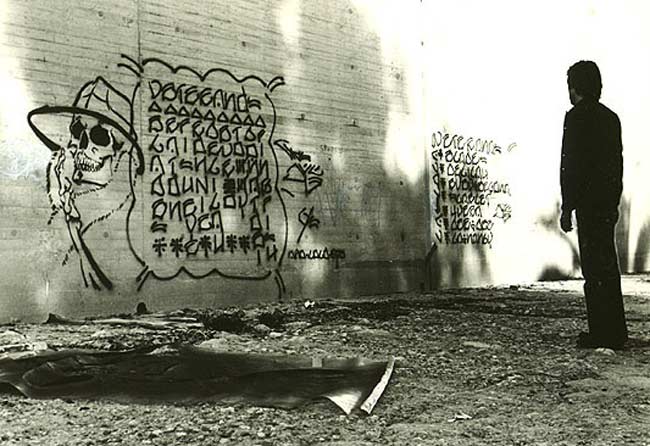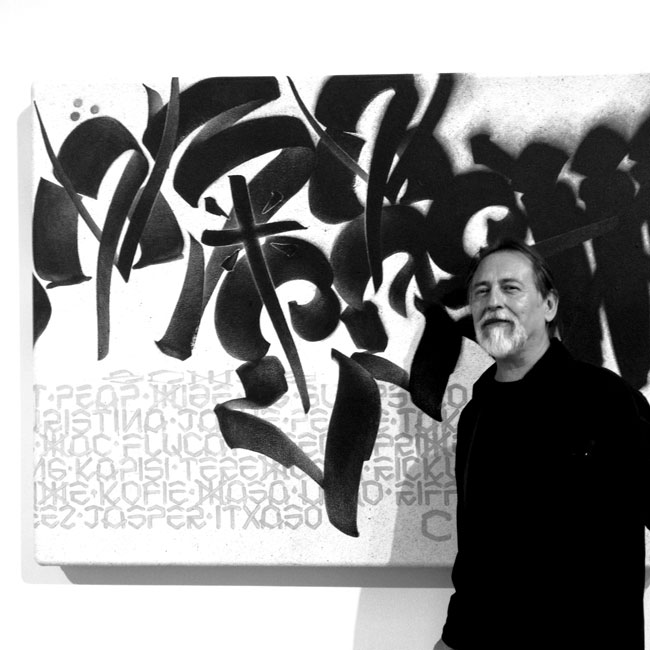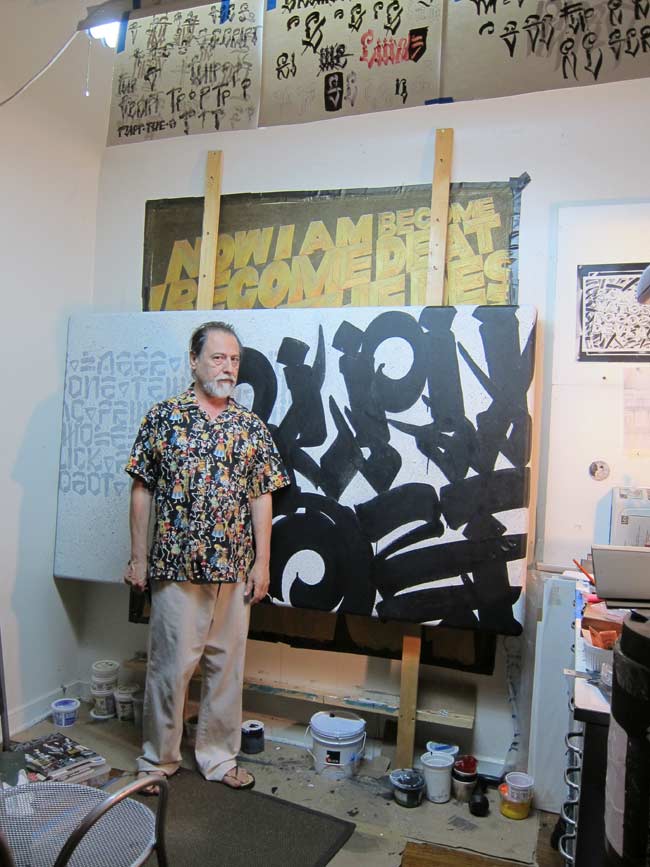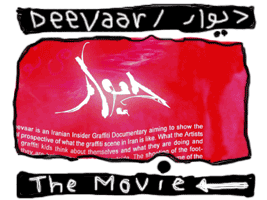KS Interview with Chaz Bojorquez


Kolahstudio is Proud to publish our recent interview with Chaz Boroquez known as the Grand father of LosAngeles Graffiti. Chaz’s use of calligraphy blends his Latin American influences of Cholo graffiti with Chinese characters, Old English text and psychedelia.His Art is Inspired from Mexican Folklore Visual elements and of LosAngeles Gangster Style writings.His Are also inspired many of Artists from younger generations and got its unique place in Story of Graffiti and Art.

KolahStudio : Hello, Would you please let us know how you started you Work as creating strange writings of Cholo Style in Streets? you started in 60s right? how you started ? was it a hobby? a Gang job? or philosophic Leftist viewpoints toward the world, etc?
Chaz: I was raised in Los Angeles during the 1950’s when the color of your skin or ethnic race made a difference. Apartheid started in the United States and it was a White majority, I was a young Mexican American trying to find my place in society.I had grandparents in Tijuana Mexico where I would spend my time at the Horse Race Track because my grandfather was the Engineer and also we would go see Bull Fighting because they lived next door to the Tijuana Bull Ring. In Los Angeles, it’s all about Hollywood and we would go to the night clubs like the ‘Whisky A Go-Go’ to go see Hendrix play guitar, so as a young man I had many interest and adventures, but I still felt alone. I was looking for something that belonged to me but could not find it. During the hot summers we would go to the small river where I live to slide in the greenish water. (All the rivers in Los Angeles are covered in concrete, no trees or life) There we would find tunnels that brought the rain water off the streets into the river, we would follow the concrete tunnels for 2 kilometers and in the dark I first found graffiti from the 1950’s written with smoke from candles and kerosene cigarette lighters, I fell in love with the letters. From that day on I wanted to write graffiti, it was special, secret and spoke to my need to have an identity. Only Mexican Americans wrote ‘Gang style’ graffiti, we called it ‘Cholo Letters’. They are a variation of ‘Old English’ and written in capital letters and always black, this tradition comes from the 1940’s during WWII. I did my first tagging in the streets of L.A. in 1969 with my image of a large human skull.
I combined my interest at that time to create my tag, the big hat and fur collar comes from the movies ‘Shaft’ and ‘Super Fly’ to represent the ‘Race’ issues in the U.S.A, I used a human skull from our Mexican festival ‘Days of the Dead’ where we celebrate our dead family members and have a party for them, the skull for us ‘Does not mean Death, but a life that continues’! this is very important to our culture. I call my skull tag ‘Mr. Lucky’, and now many men in the ‘Avenues’ street gang have it tattooed on their bodies, they say that if they are shot with a gun, Mr. Lucky with save them from death, there are a thousand men with this tattoo. I have continued writing graffiti from that day, so now I am one of the first and longest writing taggers in the world.
KS: In a country like Iran we have no high quality art products like famous brand cans markers ,etc. …do you think to make a powerful graffiti needs having powerful equipment? i think you did not have any quality cans and skinny caps ,etc so how you did it?
Chaz: I remember the year 1955 when the first ‘Spray Can’ was made commercially for Hobbyist to use. We would buy small plastic models of American Automobiles and painted them with these early spray cans. The next improvement arrived in the 1960’s by making the cans larger and it made it easier for the Los Angeles Street Gangs to start writing their graffiti all over the city for the first time. Those early ‘Krylon’ cans had weak pressure and very little pigment, they were bad, I didn’t like them, the spray paint would run down my arm when I used them they had only one tip. So I went back to the technique taggers would use before the spray can, we would use a lot of black paint in a can with a 2-4 inch brush, I liked a ‘chissel point’ and it would paint like a modern felt marker or calligraphy pen. In the 1940’s in the Los Angeles river you could find oil or tar seeping from the ground, we would put it in a metal can and leave it in the sun to warm up and with a stick you could write a tag with wet tar, some of those early tags can still be found because they weathered the best. Even today I don’t use the spray can and all of the tagging I do on the streets and on canvas are painted with a brush.
KS: it must be a time in which you change from a tagger or unknown artist to a considered or known Artist/citizen… I mean how it happened that what you started to do made its way to make today “Chaz Bojorquez”
Chaz: When I start to do graffiti in 1969 it was ‘All’ about having fun. I was at Chouinard Art School at the same time I did graffiti.
During the day I would draw people and make ceramics and at night I would tag, I never thought that graffiti was art. I took 10 years in 1980 to do my first graffiti on canvas. Even in my 30’s I bought two houses to rent for the income them they could give me in my old age so I could still paint graffiti, because I was sure there was no market or I would never make money to live on my art, but I still wanted to paint for myself, for my passion and soul. I think the computer and Internet saved me, the first Apple computer arrived in Los Angeles in 1986 and by 1996 all the graffiti scene knew everything about the New York history and style, so the youth started to look for other styles of early graffiti and they found me. My career started about 1994 when our nations national museum The Smithsonian Institute came to my studio and acquired my art for their permanent collection, in the last 15 years my wife and I have been invited to Japan, Australia, New Zealand, Italy, Spain and Mexico to exhibit and lecture. I’ve designed many products like Chaz: Vans shoes, Converse shoe, Nike shoe, ExLarge clothing, Disney products and many tattoos. My true passion is painting, so I’ve been in 400 exhibits in galleries and museums, plus interviews on television, radio and print.I did not plan or know I would be know for my graffiti, I only wanted to live an artist life.
KS: Do you think the street art scene in your country and the world is now different from the Past? if yes, would you please let us now some of the main changes which you like or dislike?
Chaz: There are many differences from when I first started tagging until now, first MONEY, second Money and third Money!! Our graffiti in Los Angeles was about our community and about being Mexican American, we tagged the names of our friends and only wrote within our own neighborhood, we never tagged ‘All City’ writing in other peoples neighborhoods, that was a big difference between Los Angeles and New York. Now you can live your life as an artist by painting graffiti, I never thought that in the future I could make a living and buy a house from my artwork. When I was in my 30’s I worked very hard in the Movie Industry in Hollywood and bought two small houses to have income when I became older, ‘I planned on not being a successful artist’ but still paint my graffiti ‘Graffiti Saved My Life’. Another big change, today we can communicate via email around the world where we can share our histories, this is wonderful!

KS: could you please let us know about Your Point of view on Street art / Graffiti scene in the world today ?
Chaz: I am still not convinced that Street Art is Graffiti. Street Art came from graffiti but it’s not graffiti. Graffiti is illegal and something you protect. Real graffiti is ‘Outside’, in the streets! but if you want to know what graffiti is about: it’s history, it’s intent, purpose, soul and passion you need to bring it ‘Inside’ in the galleries, magazines, interviews and postings on the Webb. You need a dialogue with graffiti, you need to talk about it to really know it. I enjoy listening to Street Artist (we paint together in art fairs around the world) and their stories, but there is no danger like the street gangs from Los Angeles and no culture, Street Artist only talk about themselves.
KS: How do you see Street Art ? (do you see it as a profession, a Hobby ,a mission? a way of expression? Or what?)
Chaz: Street Art is a mission of self expression like Performance Art, I see only a need to paint a large image that may have a small thought about world politics or a ‘quick expression’ like ‘OBEY’. An interesting point is that for the first time in history ‘Artist’ are invited from around the world to unite in a universal Street Art movement to paint art in the streets!, now that’s incredible. I am invited to many art events and meet many good artist (everyone is 20-50 years younger than me) and we paint together, it gives me great joy painting together with other artist on the walls, that’s the good part of Street Art it brings us all together.
KS: We know you were painting oil color on canvas but you were putting it aside from your graffiti… it means you had some ideas and borders about both sides of your creative soul. it is very interesting… maybe this idea is still alive….would you tell us about your feelings back in the days and is it still the same?
Chaz: As a young child I always knew I wanted to be an artist but I didn’t know what kind I would be when I grew up. When I found graffiti, that was a path that I would follow forever. The reason I started to paint on canvas was because I wanted to spend more time on the wall, the concept of writing names on the wall became a deeper expression and I wanted to paint every line and stroke very slowly and the best I could paint, I wanted to paint the ‘Pride and Strength’ of my friends in very line. These ideas took longer so I made a wall in my studio, a canvas wall, this allowed me to paint on one idea for many hours or days, these were my first ‘Paintings on Canvas’. Today I sometimes spend one full year on one painting, you paint until you find the ‘Perfect Image’ on the canvas, but something magical happens, ‘The painting becomes the Teacher’ and you find yourself on another path of new knowledge about who you are and what is art. Painting is my master where I can go and create ‘A Voice’ for myself.
KS: what do you think about bombing and illegal graffiti? do you think it is good to be legal or illegal? does it matter?
Chaz: Real graffiti is in the streets and I feel you can not call yourself a graffiti writer until you have a minimum of 10 years writing. Graffiti is a crime and sometimes you have to be illegal, but that is not the point of graffiti. Graffiti is about how ‘You’ feel about doing it. Do you want to be a ‘Outlaw’ or are you and Artist? I doesn’t matter what path you take about the laws, it’s about doing and ‘finishing your work’ you are only as good as your last work. A good graffiti artist must make good art and finish it to the best level he can! That is the challenge of graffiti today!
KS: Do you Feel this kind of Gallery fever in Graffiti world today? every young writer aims to show up in galleries as fast as possible?
Chaz: I have exhibited in many galleries and museum in the world, and it very important to do so. A gallery is a ‘Store’ where you sell your artwork for money. The ‘True’ value of your artwork is not the money! The true value of your art is when people ‘Believe’ in your art. When people photograph it and post it or print in art reviews and art critique, that’s how people get to know about you. Also when you paint in the streets you are anonymous and you can paint fast, but in the galleries your art is on the walls for everyone in the world to see, if you have a bad painting you can loose your reputation! Galleries can make or break your career. If you feel that the gallery system is not for you, than it will be bad for you, you can still build a career via the Webb by Face Book or Instrgram.
KS: What you think about the New Muralismus? i mean ,in the past they were Muralists and then they were graffiti writers.different jobs .different things while both were in the public. Now we see alot of Mainstream trying to merge these two together,Are you ok with it? do you like a city with no tags and graffiti and just some old school writeres or new street Artists painting walls with Lifts and elevators,Big paintings ,huge walls and Gallery shows +magazines?
Chaz: No one has control over the market of graffiti. Who am I to tell another artist what to paint or how to think about their art, all artist have the right to paint what they want, as long as an artist is working, I respect them. In my opinion, Graffiti and Murals are two different movements, the only commonality is that they both paint on street walls. Some Muralist use lifts and the writers in Sao Paulo, Brazil stand on each others shoulders to make a human ladder to tag, they are both legitimate as long as you paint the best you can on every wall.
KS: the real graffiti movement? do you believe in it or it is not important? is it still an underground independant movement or it is just a way to make fame, money , news and be in Magazines, doing Hugewalls and not answering emails of people who have less Facebook fans or …You know it is confusing…we like to know your feeling about it.
Chaz: This is the hardest question of all! You have to do what is important to you and you only!! You have to be true to yourself to create good art. No one would know me if I did not have my Face Book Fan Page on the Webb, who would know about my history if we did not have computers. But no one would care if I did ‘Bad and unfinished Graffiti’ The new graffiti movement is global, 40 years ago it was about my small neighborhood,I like it more today. It is very confusing world for new young writers, but your world is about ‘global opportunity’ something I never had.
KS: Last question… do you know something about Iran? any image you may have in mind? any thing you may have in mind?
Chaz: I always wanted to travel and see the world, so I promised myself that I would circumnavigate the world like Magellan by the age of 30. The week after my 30th birthday I left Los Angeles to Tahiti for a voyage that would take 16 months across the South Pacific and
up through Asia and on to Europe to return to Los Angeles. A portion of the voyage we had planned a flight from Thailand to Nepal, India, Pakistan and then to Teheran, Iran. I was fascinated with the ancient Persian Kings and Heroes, the knowledge they had when the European world was lost and I wanted to see the National Museum for the treasures, we were to arrive December of 1979, a month after the Americans were taken hostage from their embassy, not a good time to visit. Our countries have traveled different paths for different reasons, but the passion of Graffiti, Letters and Calligraphy have no borders. I still yearn to visit your country and see your ancient beautiful culture. Today building a bridge with World Graffiti is ‘Better’.
KS: if you have any thing for our youngest graffiti lovers in Iran,Afghanistan or other persian language countries?
Chaz: Graffiti is a language of the World and has been with us for centuries. The strength of graffiti is not ‘my’ work and it is not the graffiti the youth tag in Iran and Afghanistan, the strength of graffiti is the space ‘inbetween’, what we do ‘together’ is the strength.Being aware of each others styles unites us in a global movement. My advice to young Persians writers is to find their inner image from their own cultures, do not copy another style like 80’s New York or Los Angeles Gang style, you MUST develop into a PERSIAN STYLE. All artist must be themselves, you will make the best and most important artwork. Graffiti is about not asking for permission to paint, Graffiti is about finding your true soul.



